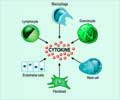MECP2 mutation is the genetic cause of Rett syndrome, which is a neurological disorder that begins after birth.

In 2005, other researchers identified the other side of the coin – MECP2 duplication syndrome. Too much of that critical protein results in other neurological problems that occur mainly in infant boys, again affecting their cognition and neurological development. These boys, however, have another troubling problem. They tend to get devastating infections, often pneumonias, that are difficult, and sometimes, impossible, to contain.
In a report that appears online today in the journal Science Translational Medicine (http://stm.sciencemag.org/), researchers from BCM, the Jan and Dan Duncan Neurological Research Institute at Texas Children's Hospital (http://www.nri.texaschildrens.org/) and the Michael E. DeBakey Veterans Affairs Medical Center (http://www.houston.va.gov/) in Houston identified the culprit in these infections. Again it was the insidious excess of MeCP2.
The study was a true translational enterprise, beginning with observations in the clinic that went into the laboratory for studies in cells and animals and may eventually emerge into the clinic again with new ways of treating and preventing the infections.
Dr. David Corry (http://www.bcm.edu/medicine/iar/index.cfm?PMID=20494), professor of medicine and pathology & immunology at BCM, and a corresponding author of the report, said children and mice with this syndrome lack a critical part of the immune system, a cytokine called gamma interferon. Gamma interferon is a vital tool in the immune system's battle against invading viruses and bacteria. Studies of human cells from people with the disorder as well as studies in mice show that both groups lack T helper type 1 (Th1) cells critical to producing gamma interferon.
Their laboratory studies showed that MeCP2 suppressed secretion of gamma interferon from T helper cells, leading to a partial immunodeficiency.
Advertisement
To reinforce their point, he and his colleagues showed that the mice were unable to fight off infection with a parasite called Leishmania major. However, they were able to fend off a fungal infection due to Aspergillus niger by mounting another immune response that involved T helper type 2 cells.
Advertisement
"Affected boys often die from pneumonia, but the mice are housed in a germ-free facility. So we needed Dr. Corry's expertise to find the problem," she said.
"The next step is to go back and aggressively figure out which pathogens are infecting these children and how best to treat them," she said.
Corry pointed out that before this study it was difficult to justify the risk involved in finding out what infections were plaguing the children. Now, that information might help with treatment and even possibly prevention.
There is also the possibility that the lack of a functioning immune system is somehow encouraging the neurological decline these infants suffer, both Corry and Ramocki said.
"The far-reaching effects of MeCP2 continue to surprise us," said Zoghbi, director of the Neurological Institute and a professor of pediatrics, neurology, neuroscience and molecular and human genetics at BCM. "This study highlights the power of combining clinical research and basic research. The finding that patients with MECP2 duplications suffer recurrent infections inspired studies in the mouse model that illuminated an important role of MeCP2 in immune responses."
Ramocki credits the response of the families of the youngsters with MECP2 duplication syndrome and the power of social media with making the study possible. Forty-five families from four different continents attended a conference on the disorder in May 2011. All communication was via the web and social media. The conference enabled researchers to collect samples from the children with the disorder, their siblings and parents for use in the research.
Source-Eurekalert














